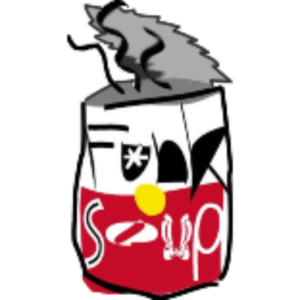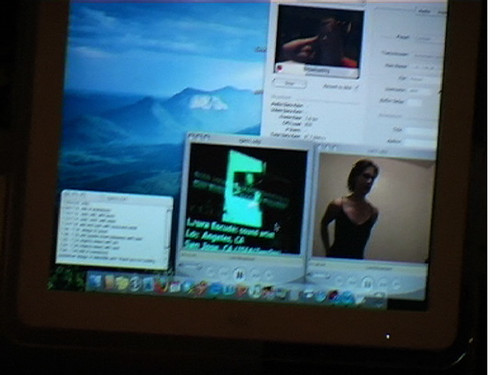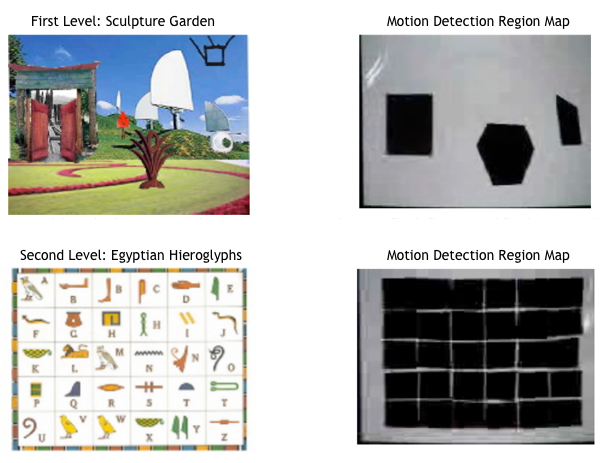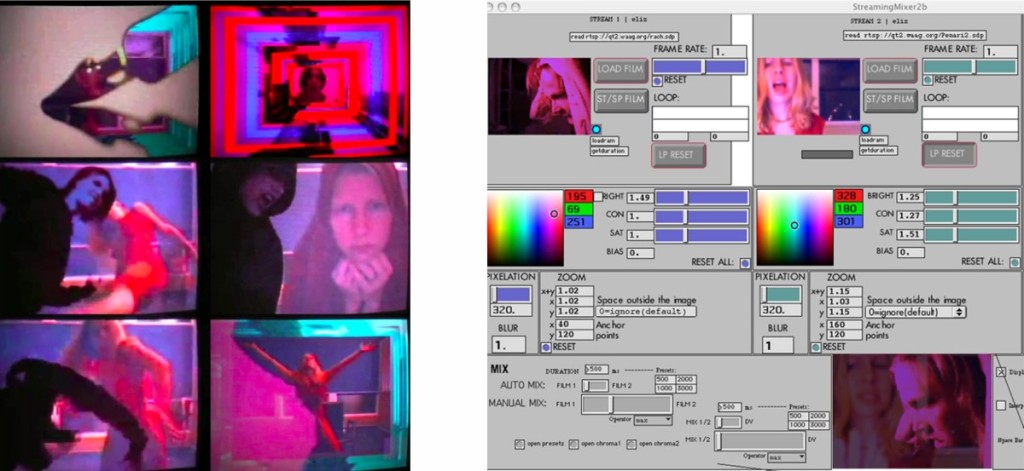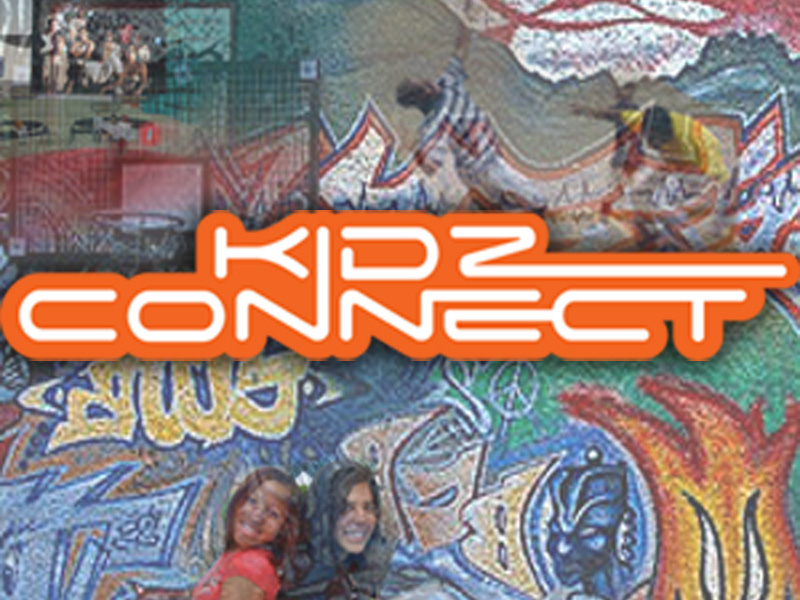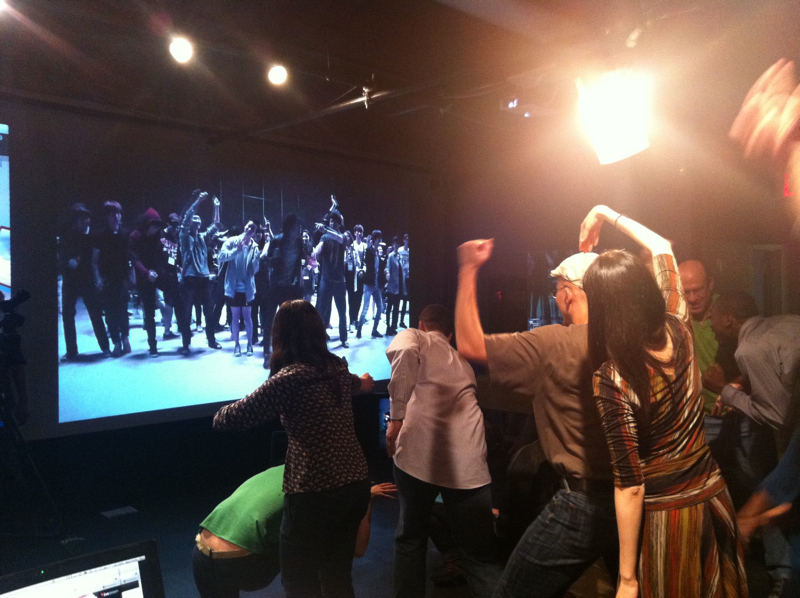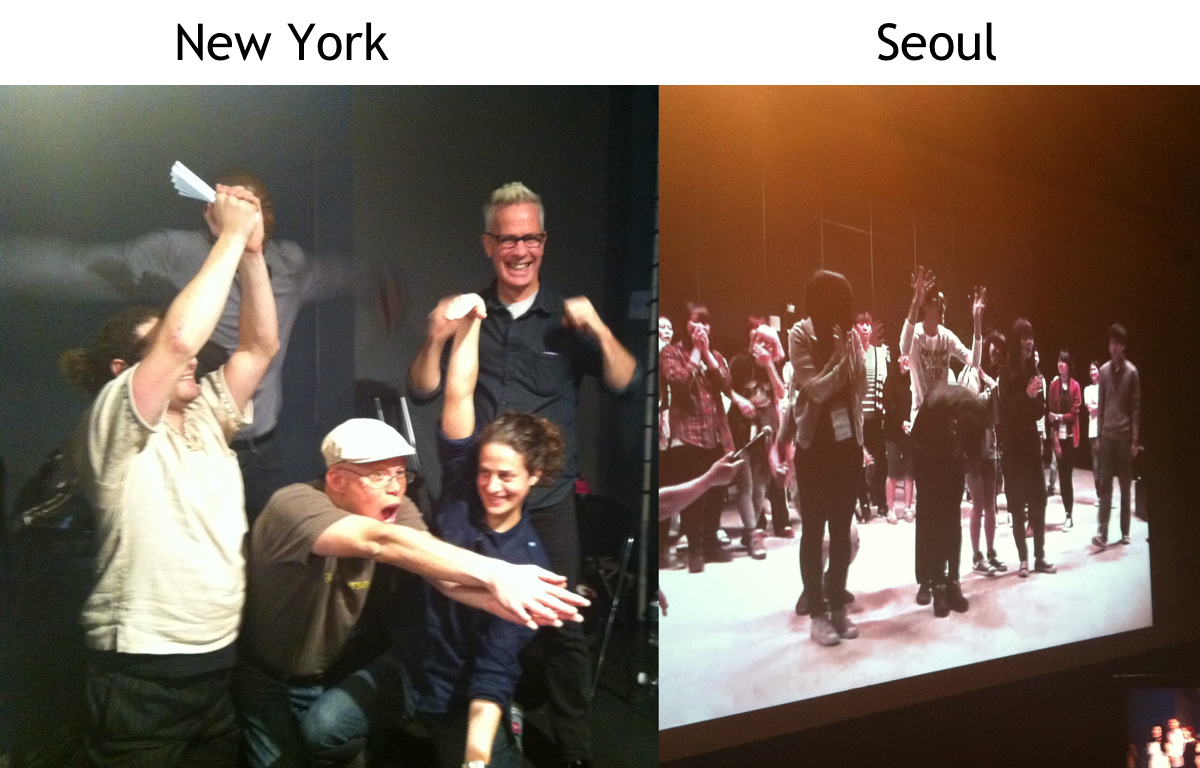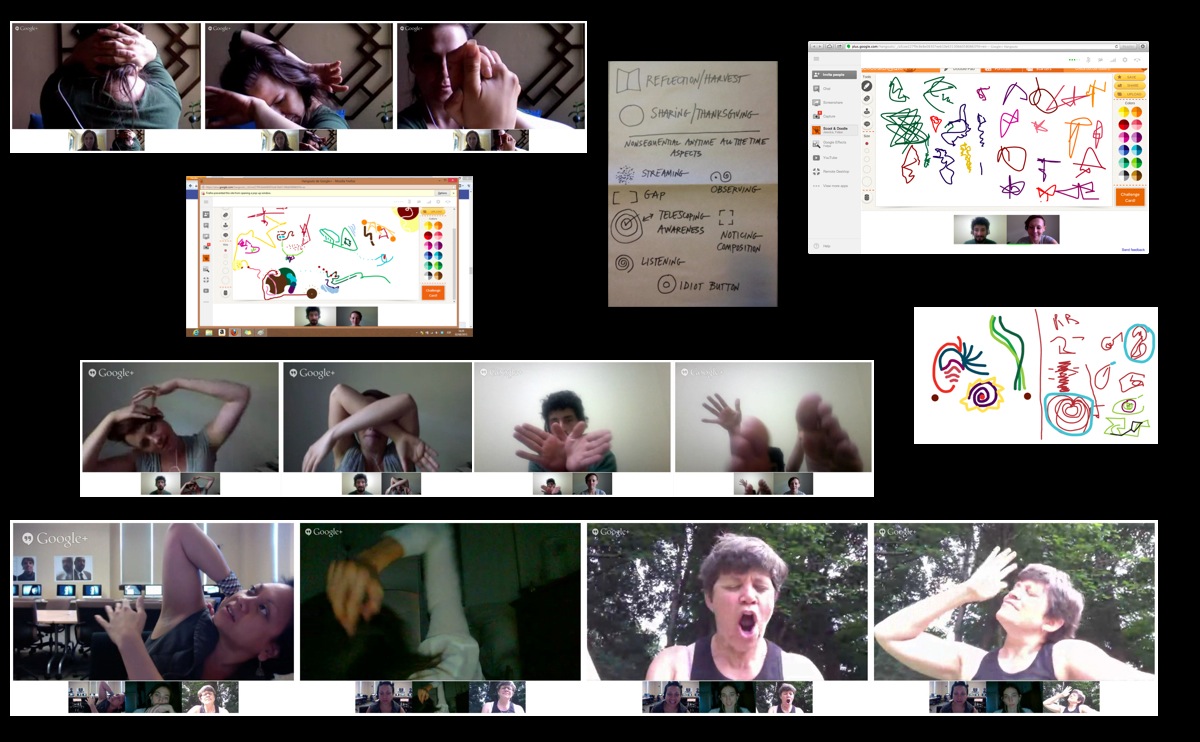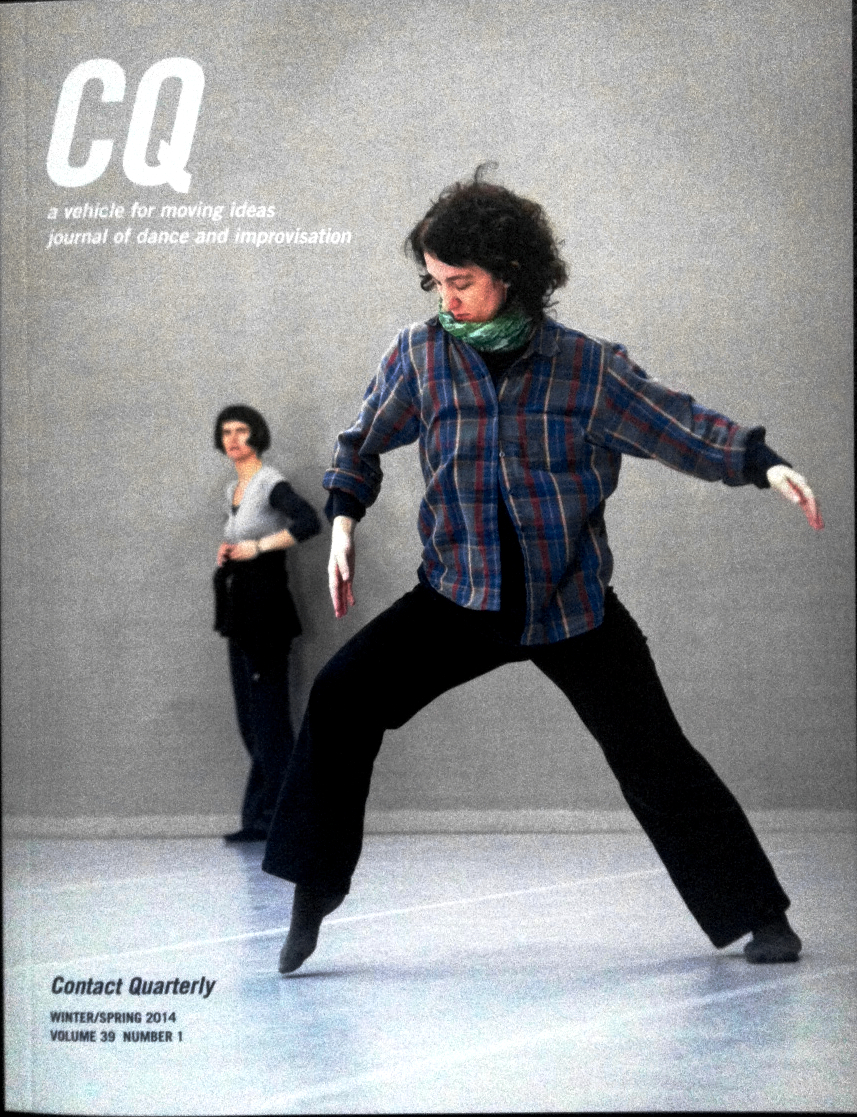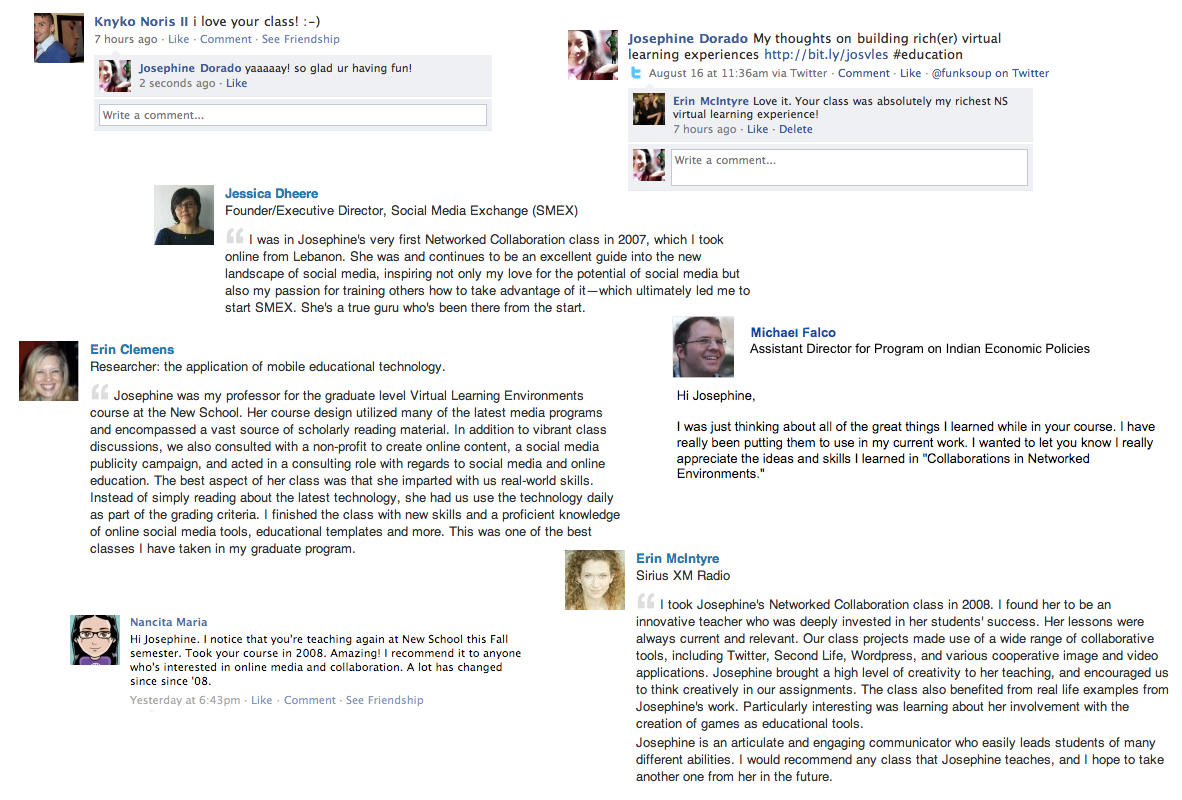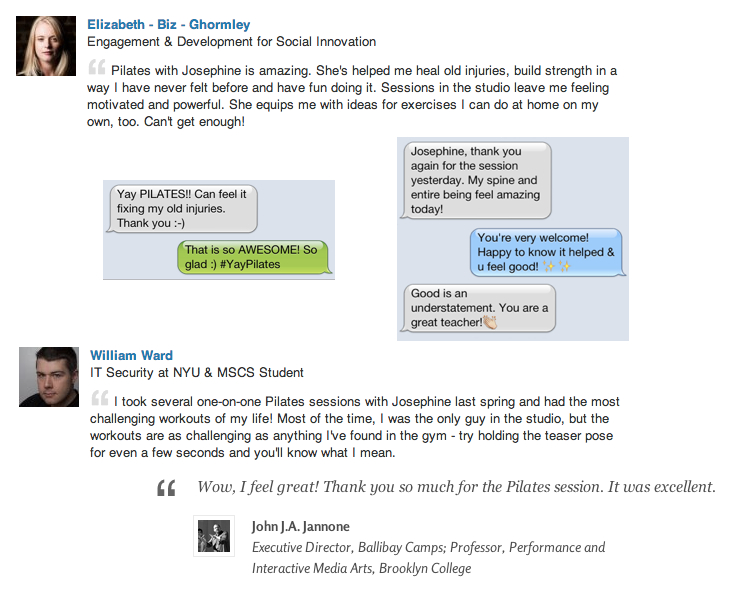How does the body manifest into online space? How can we extend performance through technology? How can we create a rich sense of rapport through online collaboration?
These are the questions I’ve been obsessed with. The answers change as emerging technologies surface, but the questions remain constant. It’s all such a dynamic and interesting field, and I’ve taken great pleasure in the research and praxis of exploring the networked body.
LET’S TAKE IT BACK
Way back. To a land where there was no such thing as Skype, Livestream or Ustream. In 2003, if you wanted to stream video, you had to have access to your own Quicktime streaming server, and even so, internet streaming only allowed for 320×240 video and about 12 frames per second. So…video…was…often…stilted — like stop-motion art. One had to be creatively resourceful. Nevertheless, I viewed the parameters as an interesting challenge: when presented with technical challenges such as network lag, how do we persist and create rich and engaging experiences?
Right around that time, I was honored to have received a Fulbright scholarship and went to Amsterdam, where I attained a residency at Waag Society to do research focusing on performance in hybrid online environments and discover some answers to the above questions. While there, I produced my first networked performances. For the purposes of this discussion, let’s define networked performance as online collaborative performance among physically dispersed participants.
CREATING A SHARED VIRTUAL SPACE
One of my first forays in the field was Viroid Flophouse in 2004, which was an exploration of playable art in an online environment incorporating movement, motion tracking, streaming and telematic performance within the common theme of “virus” and the first of many collaborations with ADaPT (Association for Dance and Performance Telematics). The original idea was for remote sites to be able to ‘infect’ each other using digital telepresence. Partner sites at the Waag Society in Amsterdam and Arizona State University in Tempe, AZ, functioned as rooms in the ‘flophouse’ in which on-site participants could interact with remote participants in this hybrid game/performance environment.
The performance took the form of a cooperative game, where players on each side of the Atlantic used motion sensing to control a graphic environment in the other or remote space. A game structure was developed: the dancer in Arizona and the dancer in Amsterdam had to position themselves in the same shared virtual space in order to get to the next level.
So one of the answers to the question “when presented with technical challenges such as network lag, how do we persist and create rich and engaging experiences?” — became the following: create a way to affect each other’s shared virtual space by sending motion data over the network. For more info, check out this report.
IMPROVISING IN A NETWORKED ENVIRONMENT
I returned from my Fulbright and realized a piece called RPM’s Remixed in 2005 which then became part of my Masters thesis, Improvising in a Networked Environment. RPM’s Remixed was a telematic, transdisciplinary performance based on remixing Alvin Lucier’s RPM’s score, integrating dance, video and sound improvisation. It was simultaneously performed in New York, Los Angeles, Tampa and Houston. RPM’s Remixed was also invited to perform as part of the ISEA 2006 Festival and ZeroOne San Jose.
Alvin Lucier, a well-known composer of music and sound installations that explore natural phenomena and resonance, is renowned for making spaces “sing.” This piece explored the possibilities of using one of his scores to make a virtual space “sing” by using improvisational techniques as well as the natural feedback and delay created by streaming. (Another answer to the question “when presented with technical challenges such as network lag, how do we persist and create rich and engaging experiences?” — don’t fight the lag, work with it! Use it as an opportunity for interesting transitions.) For more info, see this page.
It was then that a seed of an idea developed: through these networked collaborations, close friendships had grown — despite the distance, despite the fact that some of the performers had never met each other in physical space. As one of the RPM’s Remixed performers, Laura said, “I know that even though I’ve never met Emre [in physical space], I feel like I know him really well.” Why not create a virtual cultural exchange program that utilizes performance as a vehicle for creating cross-cultural friendships?
CONNECTING CULTURES THROUGH ONLINE PERFORMANCE
Inspired by these interdisciplinary, international collaborations, I initiated the Kidz Connect program and we realized the pilot project in 2006. Kidz Connect is a virtual cultural exchange program that connects youth in different countries through creative collaboration and performance in virtual worlds. Cultural exchange is at the heart of international conflict resolution, yet the experience of cultural exchange through traveling is not accessible for many youth.
The backbone of Kidz Connect is based on improvisational performance, dance and digital storytelling as frameworks for online collaboration and cross-cultural exchange. Through these frameworks, which encourage active listening and interaction, we can build richer online rapport, allowing participants to instantly connect and cooperate regardless of geographical location or previous experience with performance or digital media.
The Kidz Connect pilot project was launched between students in New York City and Amsterdam, Netherlands. Students in New York connected and created with students in Amsterdam through movement, improvisational performance and digital storytelling in the virtual world Teen Second Life.
Guided by artists and educators from theatre and digital arts, students learned skills like Playback Theatre (improvisational storytelling technique), dance improvisation, digital storytelling, and 3D modeling. In Teen Second Life, they met and collaborated to build a hybrid virtual city combining aspects of both New York and Amsterdam. Within that common space, they created a performance that simultaneously occurred live and online.
The project continued with a program in 2008 involving students at the Patel Conservatory in Tampa, Florida and students at the IVKO Montessori School in Amsterdam. The students wrote, created and performed a live show in Teen Second Life, learning about each other’s culture in the process through music, dance, digital art and/or storytelling within this virtual world.
EXPLORING CULTURAL IDENTITY THROUGH DANCE AND DIGITAL ROLEPLAYING
The program has since then taken other manifestations, each tailored to meet the needs of the youth community and engage the students in a creative way. In 2009, we realized a project with teens from the Macondo refugee community on the outskirts of Vienna, Austria, in partnership with Cabula6 and Tanzquartier Wien. The project, called Macondo Dance Connect, was a mixed reality performance project which brought kids together from the Macondo refugee community using dance, mapping, and digital storytelling.

Students in the Macondo Dance Connect program dancing as avatars in Teen Second Life as well as in the physical space (seen on the video screens above the stage)
The objective was to re-connect youth from the refugee community to their native cultures by creatively exploring their own history and current living circumstances, while allowing them to discover the nature of cultural identity through storytelling and performance in virtual space.
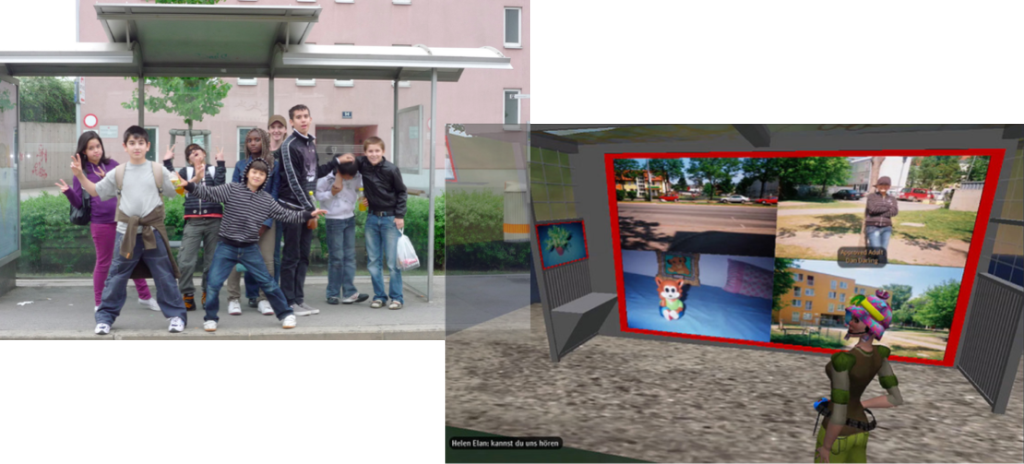
Macondo Dance Connect students in front of the Zinnergasse-Kaserne bus stop, which is the only bus that goes into and out of the Macondo refugee community. Students created their own virtual bus stops, personalized with their stories & images in the virtual world Teen Second Life. When you click on the virtual bus stops, they display each student’s story of their journey to the Macondo.
As part of Macondo Dance Connect, participants explored cultural identity through the use of avatars and roleplaying. Avatar roleplaying enabled them to expand their notions of evolving identity — allowing them to play with different skin colors and body shapes, making identity dynamic and creative precisely at a moment in their lives when their multiple identities are both in flux and in danger.
MORE NETWORKED AWESOMENESS
A slew of networked performances ensued after that, including the following, among others:
Mixed Reality Improv at ISIM: a mixed-reality improvisation between Pauline Oliveros, Ione and performers in the physical space at the International Society of Improvised Music (ISIM) and performers in the virtual world of Second Life in NYC, Arizona State University and Amsterdam.
3×3/30×30: a mixed reality performance that incorporated live dance and video in Rome and the virtual world Second Life, performed as part of the Romaeuropa Festival. Choreographer Paul André Fortier danced a 30-minute solo everyday, at the same time, for 30 days, in an open urban space, totally exposed to the weather and passers-by in the Piazza San Lorenzo in Lucina (Rome, Italy). In Second Life, a set of parallel performances was presented in which there were 3 performances in 3 different places for 3 minutes at a time. The closing festival party included a mix of Fortier’s live 30×30 performance with the 3×3 performance.
Firsthand Performances: a hybrid live installation and performance at the Encuentro Festival in Bogota, Colombia. The project explored the fusion of physical and online performance and invited public thoughts on ideas of “performance.”
MASHING UP GAME SPACE WITH TALK SHOW ANTICS
The natural progression of exploring collaboration in networked space took me to game spaces as well. In 2009, I joined the crew of This Spartan Life, a talk show inside the game Halo, as Live Events Producer specializing in live performance events that happen simultaneously in the game space as well as physical space (another version of mixed reality). Wired Magazine likened it to “a mashup of The Charlie Rose Show & Doom” and we’ve been featured at festivals such as South by Southwest (SXSW) and PICNIC (Amsterdam).
DEEPER DIVE: EXPLORING IDENTITY
More recent work blends immersive environments with improvisation, streaming, storytelling and identity play, such as #IdentityMashup. The #IdentityMashup lab was conducted by me and Phillip Gulley at La MaMa’s CultureHub in partnership with Seoul Institute of the Arts, as part of a networked ARTALK in which participants in NYC and Seoul, South Korea, connected and collaborated. Participants in the #IdentityMashup lab created (dis)embodied stories based on Jung’s shadow archetype, and explored identity through a mashup of avatar roleplaying, livestreaming and performance in a mixed reality environment.
Short stories based on shadow work were told through an avatar whose face was mapped to a live video stream of the participants’ actual faces, creating hybrid physical-online identities that were simultaneously distorted and revealing.
When we creatively explore our personal histories and current circumstances, we question the nature of reality, cultural identity and home. Mixing realities and integrating movement exploration challenges pre-conceived notions of cultural identity, opening the door to fantastic tales as well as a grounding sense of empowerment as we journey through virtual and real interpretations of migration and integration, inspired by our past as well as future identities.
Participants in NYC shared improvisational dance movements with participants in Seoul based on stories both groups had written and brought to life. Camaraderie was explored across cultures, where groups of strangers transformed themselves into a hunting hawk, an operating room complete with vital signs monitor, and an all inclusive organic machine riffing on words derived from the writings. For more info on the #IdentityMashup lab, go to this page.
SELMA JEANNE COHEN AWARD
I was honored to receive Fulbright’s esteemed Selma Jeanne Cohen Award for international scholarly research on dance in 2012. At the Annual Fulbright Conference in London that year, I gave a presentation entitled Instant Online Collaboration: Just Add Dance focused on the use of dance frameworks for online collaboration and linking physical to digital actions.
ONLINE EMBODIMENT AND CO-CREATION
#MetaAcademy is an online lab exploring embodiment and co-creation on the internet using movement and other improvisational ideas. The 3-week pilot program was realized at Bates Dance Festival in Maine and online. MetaAcademy participants used internet-based tools to creatively explore questions about embodiment, training and memory, composition, and politics of the body, as well as how to translate embodied practices onto the internet. The lab was structured around Nancy Stark Smith’s Underscore, an approach for improvisational dance/movement that she has been developing for over 30 years, which she taught at Bates Dance Festival 2013. #MetaAcademy @ Bates was facilitated by me, Marlon Barrios Solano and Rachel Boggia.
My specific role involved building the foundation for the embodied online collaborations (advising on technological platforms and the nuances of blending physical+digital presence), generating curricula and overall subject matter expertise. The infrastructure which I recommended (using Google Hangouts for multi-modal, real-time video conferencing and collaborative whiteboarding with Nancy Stark Smith’s Underscore glyphs as improvisational prompts) became the foundation for many global dance improvs throughout the MetaAcademy @ Bates workshop. What initially began as a Networked Collaboration Consultant role subsequently morphed into a Co-Founder role.
Examples:
1. Example of curricula which adapts Nancy Stark Smith’s Glyphs to online space via collaborative whiteboarding and movement in Google Hangout: Duet and Trio Google Hangouts/Collaborative Glyphs
2. Example of two participants, Lisa Parra and Daniel Pinheiro, doing an embodied investigation, facilitated by our instructions which adapt Nancy Stark Smith’s Underscore to a duet in online space:
My top 5 takeaways for embodied online collaboration (see it full size here):
For more details on #MetaAcademy, go to this page and for more details on the Contact Quarterly article, go to this page.
THE NEW SCHOOL
At The New School, I teach graduate and undergraduate courses in the School of Media Studies, with a focus on virtual learning experiences, collaboration in networked environments and remix culture. I think my former students sum up their experience pretty well in this montage (click for larger view):
YAYPILATES
YayPilates is my effort to balance a technology-infused life with a physical, embodied way of being. Smart workouts = smart brains & bodies = smart living, and a healthy core and lifestyle are integral to that. By teaching Pilates, I balance my work in hybrid online spaces with my passion for embodiment and fitness. Here are comments from some of my Pilates clients:
YAY, FULBRIGHT
After many years of serving on the board of directors and helping to build NY’s Fulbright community, I’m also the current President of the Fulbright Association’s Greater New York Chapter. As such, I bring to the table my extensive network of contacts throughout the national and international Fulbright community, State Department and cultural attachés. The NY Chapter of the Fulbright Association is a very active chapter and we’ve initiated some ambitious and innovative new programs. We also hold monthly salons, panels and other events, so opportunities for collaboration on a local and/or international level abound.
THOUGHT LEADERSHIP
Last but not least: speaking — I do a lot of it and enjoy talking about emerging technologies and the ways we can creatively leverage it. Recent speaking engagements are below and more are outlined on the portfolio section of this site under the “Speaking” tag.
TechCamp Ramallah: Ramallah, West Bank. Presenter/Trainer. Topic: Mobile Storytelling & Educational Games. Hosted by the State Dept. & the American Consulate General in Jerusalem.
Fulbright NY: Women in Tech: New York, NY. Moderator. Topic: Mobile & Mapping toward Resilience & Recovery. Featured women in the mobile and mapping fields focused on crisis response and resilience-building.
Talks @ Google: New York, NY. Moderator. Topic: The Role of Arts in Resilience.
THIS BODY IS NETWORKED MOBILE GAME
The “This Body is NETWORKED” game concisely encapsulates my journey into networked performance and exploring the body in online space. It is meant to augment the following narrative with a game-like experience so that place and space are tied to stories and learning actions. You can download and install the 7scenes app to your mobile. It’s free, and it’s both Android and iPhone/iPad compatible. Search for “7scenes” in the App Store or Google Play store and install it. Create a username/account and log in. Once you’re logged in go to Scenes > Search and search for the This Body is NETWORKED scene. Select it then press “Start” to start the experience.
SO MUCH MORE, HOW DO I END?
Like this, THE END
Sort of.
Find me:
The best place to find me is in the cloud:
Twitter: @funksoup
Facebook: http://facebook.com/funksoup
LinkedIn: http://linkedin.com/in/funksoup
And quite literally sometimes, in the clouds:
